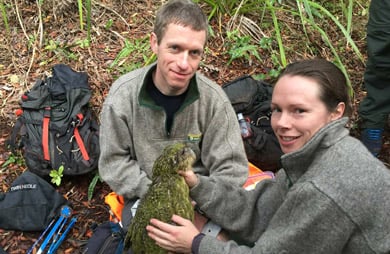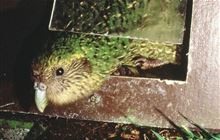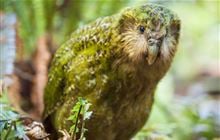Kākāpō
Introduction
The kākāpō is a nocturnal, flightless parrot. And its strangeness doesn't end there. It's critically endangered and one of New Zealand’s unique treasures.
Andrew Digby and Deidre Vercoe health-check a kākāpō chick
Image: Lou Sanson | DOC
There are only 247 kākāpō alive today.
New Zealand status: Endemic
Conservation status: Threatened – Nationally Critical
Found in: Codfish Island/Whenua Hou, Anchor Island and Te Hauturu-o-Toi/Little Barrier Island
Threats: Predators, disease, genetic inbreeding, infertility
Sound recordings:
Kākāpō male 'booms' (MP3, 2,102K)
02:14 – Adult male 'booming' to attract females.
Kākāpō male 'chings' (MP3, 345K)
00:22 – Adult male 'chinging' to attract females.
Kākāpō male territorial calls (MP3, 2,361K)
02:30 – Adult male giving territorial calls (00:43). Screaming in answer to playback of booming call played through amplifier.
Kākāpō female song (MP3, 1,396K)
01:28 – Adult female.
Species information: Kākāpō on NZ Birds Online






